
Rancho Petaluma Adobe is a historic ranch house in Sonoma County, California. It was built from adobe bricks in 1836 by order of Mariano Guadalupe Vallejo. It was the largest privately owned adobe structure built in California and is the largest example of the Monterey Colonial style of architecture in the United States. A section of the former ranch has been preserved by the Petaluma Adobe State Historic Park and it is both a California Historic Landmark and a National Historic Landmark. The Rancho Petaluma Adobe State Historic Park is located on Adobe Road on the east side of the present-day town of Petaluma, California.
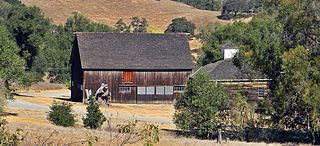
Olompali State Historic Park is a 700-acre (2.8 km2) California State Park in Marin County, California. It is constituted of the former Rancho Olómpali and was the site of the famed Battle of Olómpali during the Bear Flag Revolt. Rancho Olómpali was purchased by the Californian government in 1977, which turned it into a public park.

The Juan de Anza House, also known as the Casa de Anza, is a historic adobe house in San Juan Bautista, California. Built around 1830, Casa de Anza is a well-preserved example of residential construction from the period of Mexican California. It was declared a National Historic Landmark in 1970.

Rancho Guajome Adobe is a historic 19th-century hacienda in Rancho Guajome Adobe County Park, on North Santa Fe Avenue in Vista, San Diego County, California. Built in 1852–53, it is a well-preserved but late example of Spanish-Mexican colonial architecture, and was designated a National Historic Landmark in 1970. It is also a California Historical Landmark and on the National Register of Historic Places.
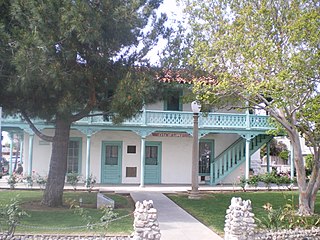
Lopez Adobe, located at 1100 Pico Street in San Fernando, California, is one of the two oldest private residences in the San Fernando Valley. Built in 1882 by early settlers of the San Fernando Valley a short distance from the San Fernando Mission, it was listed on the National Register of Historic Places in 1971.
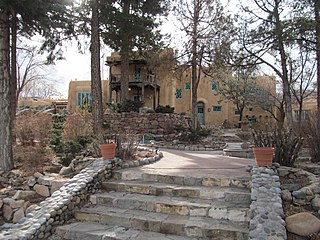
The Don Gaspar Historic District is a historic district in Santa Fe, New Mexico. It was listed on the National Register of Historic Places in 1983. The listing included 278 contributing buildings.

The Barrio de Analco Historic District is a National Historic Landmark District centered at the junction of East De Vargas Street and Old Santa Fe Trail in Santa Fe, New Mexico. The seven buildings of the district represent one of the oldest clusters of what were basically working-class or lower-class residences in North America, and are in a cross-section of pre-statehood architectural styles. It includes two of the oldest colonial-era buildings in the southwest, the San Miguel Mission church (1710), and the "Oldest House", built in 1620 and now a museum. The district was declared a National Historic Landmark in 1968.
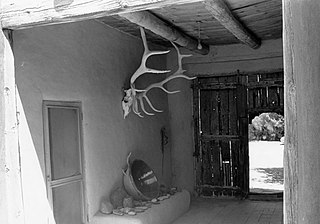
The Georgia O'Keeffe Home and Studio is a historic house museum in Abiquiú, New Mexico. From 1943 until her death, it was the principal residence and studio of artist Georgia O'Keeffe (1887–1986). It is now part of the Georgia O'Keeffe Museum, which has sites in Santa Fe and Abiquiú. Public tours are available March–November, with advance tickets required. The Home and Studio became a National Historic Landmark in 1998, as one of the most important artistic sites in the southwestern United States.
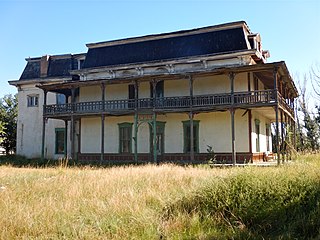
Mills House is a house in Springer, New Mexico, in Colfax County, New Mexico, that was built in 1877. It was listed on the U.S. National Register of Historic Places in 1970. The locals have dubbed it the "Clegg Mansion”, after Luke and Myrtle Clegg who owned and lived in the house for several decades beginning in about 1915.

The Donaciano Vigil House is an adobe house built in 1832 in Santa Fe, New Mexico. It was listed on the National Register of Historic Places in 1972. It was home of Donaciano Vigil, the first Hispanic governor of New Mexico under US rule.
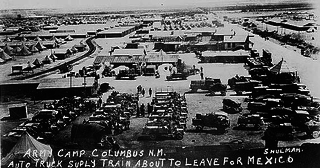
The Village of Columbus and Camp Furlong is a National Historic Landmark District commemorating the 1916 raid by Pancho Villa on the town of Columbus, New Mexico, and the American military response to that raid, the "Punitive Expedition" led by General John J. Pershing. The raid and its response, set during World War I, the Mexican Revolution, and an accompanying low-level Border War, played a significant role in diplomacy and military preparedness for eventual American entry in the World War. The district encompasses buildings which survived the raid, and military facilities used in the American response. The landmark designation was made in 1975.

The Larkin House is a historic house at 464 Calle Principal in Monterey, California. Built in 1835 by Thomas O. Larkin, it is claimed to be the first two-story house in all of California, with a design combining Spanish Colonial building methods with New England architectural features to create the popular Monterey Colonial style of architecture. The Larkin House is both a National and a California Historical Landmark, and is a featured property of Monterey State Historic Park.

El Pueblo de Los Ángeles Historical Monument, also known as Los Angeles Plaza Historic District and formerly known as El Pueblo de Los Ángeles State Historic Park, is a historic district taking in the oldest section of Los Angeles, known for many years as El Pueblo de Nuestra Señora la Reina de los Ángeles del Río de Porciúncula. The district, centered on the old plaza, was the city's center under Spanish (1781–1821), Mexican (1821–1847), and United States rule through most of the 19th century. The 44-acre park area was designated a state historic monument in 1953 and listed on the National Register of Historic Places in 1972.

Boggsville is a former settlement in Bent County, Colorado, USA near the Purgatoire River about 3 miles (4.8 km) above the Purgatoire's confluence with the Arkansas River. It was established in 1866. The surviving structures are among the earliest examples of Territorial architecture in Colorado. Boggsville was the last home of frontiersman Kit Carson before his death in 1868 at Fort Lyon. The U.S. Post Office at Las Animas now serves Boggsville postal addresses.
In the United States, the National Register of Historic Places classifies its listings by various types of architecture. Listed properties often are given one or more of 40 standard architectural style classifications that appear in the National Register Information System (NRIS) database. Other properties are given a custom architectural description with "vernacular" or other qualifiers, and others have no style classification. Many National Register-listed properties do not fit into the several categories listed here, or they fit into more specialized subcategories.
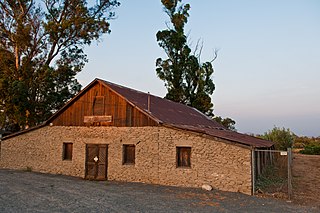
The Yorba–Slaughter Adobe is a historic adobe house located at 17127 Pomona Rincon Road near Chino, California. Built in the early 1850s, the adobe is typical of the building style prevalent during and around California's period of Mexican governance. Raimundo Yorba built the adobe on land thought to be part of Rancho El Rincon, a land grant owned by his father, Bernardo Yorba; however, a later survey determined the adobe was not part of the rancho. The younger Yorba lived in the adobe until 1868, when Forty-Niner and Mexican–American War veteran Fenton M. Slaughter bought the house. Slaughter, who later served in the California State Assembly, lived in the house until his 1897 death.

The D. H. Sutherland House, on Main St. in La Luz, New Mexico, was listed on the National Register of Historic Places in 1980. It was built around 1870 by Mariano Ramirez as a three-room, flat-roof, adobe house with small, high windows for "protection from enemies". The house was modified by Dave H. Sutherland after he bought it in 1890, adding a gable roof, a south-facing screened porch, and a number of rooms, and reflecting Victorian influences.

Los Luceros Hacienda, in Rio Arriba County, New Mexico near Los Luceros, New Mexico, is a historic site which was listed on the National Register of Historic Places in 1983. The hacienda property adjoins, or is close to, the Rio Grande. It is on a private road about .25 miles (0.40 km) off County Route 41

The House at 303 Eaton Avenue, in Socorro, New Mexico, was built in 1893 and was listed on the National Register of Historic Places in 1991.



















